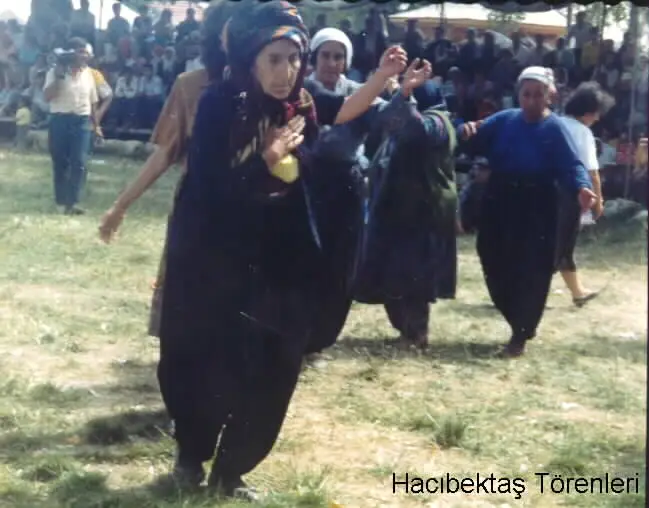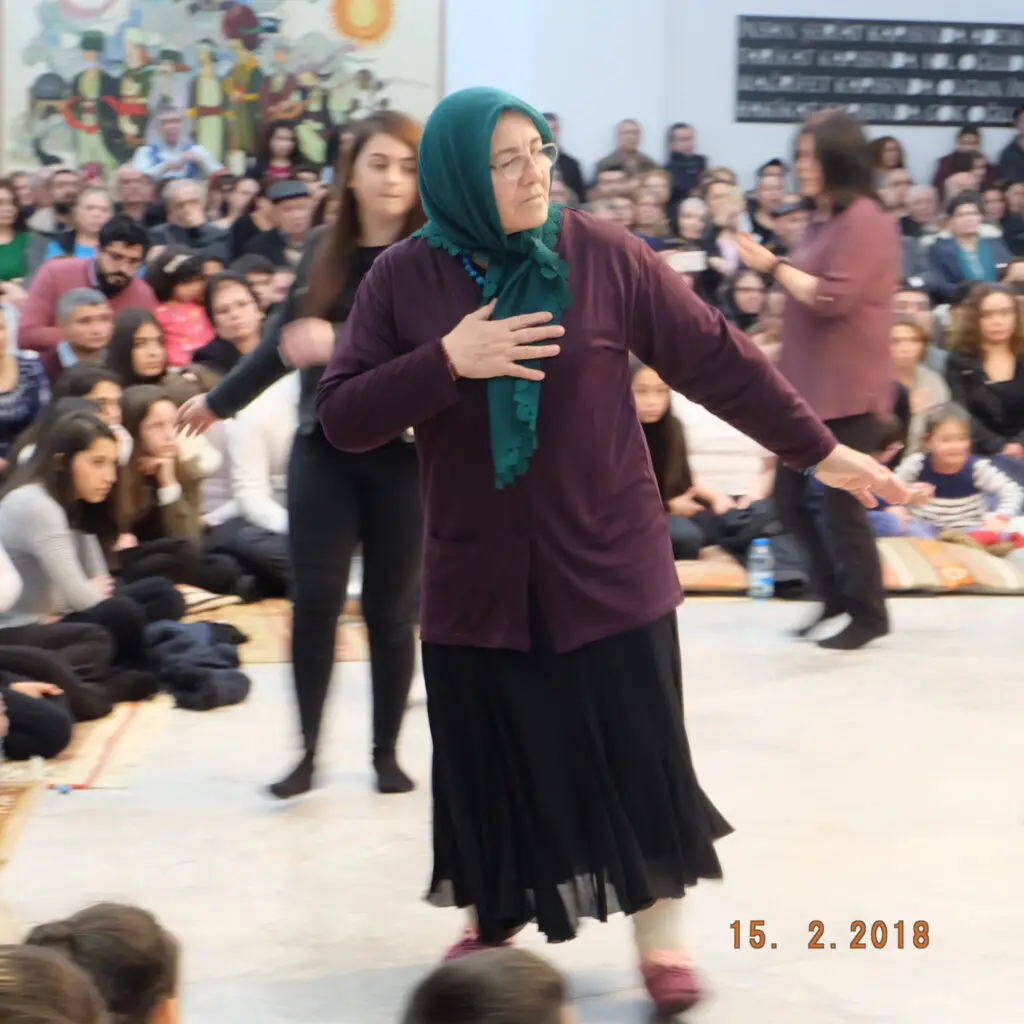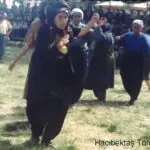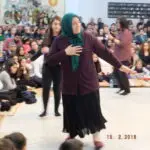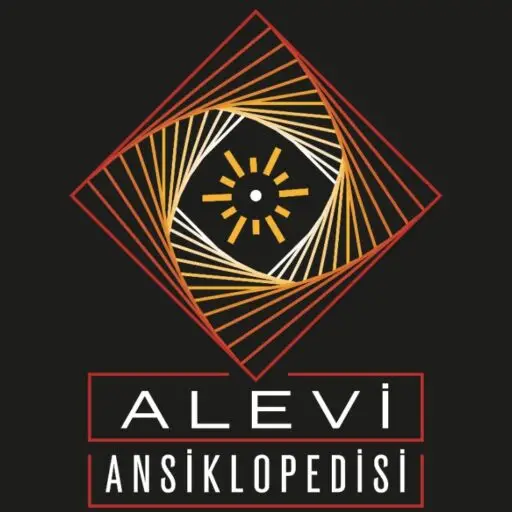Women in Alevism
* This entry was originally written in Turkish.
In Alevism, women are not only foundational to social life but also to the spiritual cosmos. In Alevi theology, female womb is revered as the ‘gate of birth (Doğum Kapısı)’, the first site of divine manifestation (tecelli), and this ontological framework grants women a central place in the Alevi belief system. Sacred femininity is symbolically embodied through figures such as Ana Fatma and is intertwined with natural and cosmic imagery. The position of the Ana (literally mother, means female member of sacred lineage) within the ocak lineage system, along with historical examples of female leadership, reflects this unique status in the social sphere. The absence of gender segregation in ritual, the lack of dress codes for women, and the emphasis placed on girls’ education all reinforce the egalitarian aspects of Alevi religious practice. However, this discourse does not always translate seamlessly into practice; Alevi women continue to face multi-layered forms of inequality. This entry explores the place of women in Alevism through the lenses of sacredness, representation, and lived experience.Theological Foundations: Sacred Femininity in Alevism
In the Alevi belief system, women occupy a central position not only in social life but also at the theological level. Woman is regarded as the first being through whom the Divine (Hak) manifests; birth is seen not merely as a biological event, but as the starting point of existence and of spiritual cosmology. Başköylü Hasan Efendi, a renowned 20th-century pir (religious leader) and Alevi scholar from the Dersim–Erzincan region, offers a profound philosophical interpretation of the ‘gate of birth (Doğum Kapısı)’. According to him, “Truth is proven in birth,” and for this reason, the gate of birth is the “gate of Hakk.” All beings are believed to pass through this gate; birth is not only a beginning, but a divine manifestation on earth (Özcan 1992).
Hasan Efendi states that the ‘gate of birth’ is realised through woman and she is regarded as the nişangeh (divine sign, marker) of this gate. Therefore, she is shown great reverence and considered untouchable in this sacred capacity. This understanding portrays woman as the carrier not only of individual life, but of an experience that is shared by all of existence. Birth is not limited to humans; it is the origin of all being. As such, the ‘gate of birth’ is defined as the first gate of Hakk, through which prophets, saints (evliyas), and holy figures are believed to have come. Accordingly, woman is positioned as a sacred being in whom ‘truth’ (hakikat) is embodied. The womb is seen as the passage through which the sacred flows and the divine truth becomes manifest on earth (Özcan 1992).
In this framework, birth is not simply the start of a new life; it is also the visible expression of a divine truth that sustains existence. Woman, as the bearer and representative of this process, is the earthly reflection of Hakk. In Alevism, woman is not only equal but also sacred; she is a foundational subject of existence, faith, and the spiritual path. This understanding elevates woman not merely as a socially revered figure, but as a sacred and inviolable subject at the ontological level. In this context, she is granted the status of mürşid (spiritual guide) as the “owner and mother of the path.”
The figure of Ana Fatma (Mother Fatma) exemplifies this sacred femininity as a spiritual archetype. Symbolising inner purity and esoteric wisdom, Ana Fatma is associated with beauty, cleanliness, and divine light (nur). In Dersim especially, the full moon is seen as her reflection or image; during full moon nights, people pray with the invocation “Ya asma bumbarekê, ya sıreta Ana Fatma!” (“O sacred moon, O image of Ana Fatma!”) and kiss the spots where the moonlight touches the ground three times in reverence. Ana Fatma offers Alevi women a spiritual and worldly role model, reinforcing their place in both the religious sphere and broader society.
The Institution of Ana (Spiritual Motherhood)
Although women’s representation within the domain of religious authority is often limited in Alevi communal structures, the traditional ocak (sacred lineage) system affords a special place to the figure of the Ana. Ana—literally meaning ‘mother’—is a woman descended from an ocak lineage, a heritage that confers a degree of spiritual legitimacy and social status. Through this position, women can exercise influence in areas such as transmission of faith, prayer, himmet (sacred support or blessing), and spiritual guidance within the community.
While the role of Ana does not entail direct authority equivalent to that of Pir (male religious leaders), this limitation appears to be shaped by historical and geographical conditions. The tradition of visiting dispersed followers (talips) in remote villages during the winter months, combined with harsh terrain and the burden of childcare typically falling on women, meant that these responsibilities were generally undertaken by male members of the ocak. This de facto arrangement led to religious services being carried out primarily by men and resulted in reduced public visibility for anas.
Despite this, the institution of ana has endured as a spiritual authority that guides, protects, and unifies. In this sense, the figure of the ana functions as a traditional role model that reinforces the respected status of women within Alevi society. The position of elderly women within the community carries not only familial but also spiritual significance.
Historically, some examples demonstrate that this figure was not merely symbolic. One striking example is that of Anşa Bacı, who lived in the 19th century. She founded her own ocak system and gathered around her a group of followers known as the Anşa Bacılar (Anşa Sisters). This community developed its own social structure and value system (Selçuk 2012). The case of Anşa Bacı is significant as it illustrates how women, under particular historical conditions, have achieved charismatic leadership and assumed foundational roles within religious frameworks.
Although the role of Ana provides women in Alevism with partial access to religious representation, this access is usually tied to lineage, age, and their recognition within the community. Nonetheless, this structure reveals that women are not excluded from the Alevi spiritual sphere; in fact, under certain circumstances, they may hold meaningful and effective positions of representation.
The Egalitarian Foundations of Alevism
Alevism is a belief system grounded in a direct relationship between the individual and the spiritual realm, centring inner experience and spiritual maturity. This approach transcends gender distinctions and defines individuals through the concept of can (soul). The term can recognises women and men as gender-neutral subjects; each individual is considered an equal agent on the path to truth (hakikat). The practice of men and women praying together, turning the semah side by side in cem rituals, and sharing the same communal table constitutes a tangible ritual expression of this egalitarian understanding.
In Alevi religious practice, there are no dress codes imposed on women; they may attend cem ceremonies in attire of their own choosing. This freedom is often emphasised in contrast to Sunni Islamic practices and is highlighted as a marker of Alevism’s modern and secular dimensions (Hanoğlu 2025; Uyanik 2004; Akdemir 2023). Indeed, such features are central to the discourses that shape and distinguish Alevi identity from other religious traditions.
Similarly, the importance placed on girls’ education is frequently underscored in Alevi communities. Education is regarded not only as an individual right but also as a communal responsibility essential to securing the future of the community. In this sense, education functions not only as a symbol of gender equality but also as a tool for women’s empowerment and their active presence in the public sphere (Hanoğlu, Weiss, and Kaczorowski 2025).
Gender Equality in Practice
In Alevism, there exists a strong discourse emphasising gender equality. This discourse is shaped around the perception that Alevi women enjoy greater freedom, visibility, and equality in comparison to Sunni Islamic contexts (Hanoğlu 2025). The ability of women to worship alongside men in cem ceremonies, the absence of mandatory veiling, and the value placed on girls’ education are key pillars of this equality narrative. However, the extent to which this discourse is reflected in daily life and institutional structures remains contested.
Narratives shared by Alevi women demonstrate that this discourse plays a central role in shaping their gender identities. While Alevism is perceived as a religious and cultural practice that promotes secular values and gender equality—thus providing women with confidence and representational space—it can simultaneously obscure existing inequalities (Hanoğlu 2025). Indeed, this emphasis on equality is often mobilised to assert Alevism’s distinctiveness from Islamic norms, yet it is not always institutionalised in practice (Okan 2018; Akdemir 2023; Uyanık 2004).
In practice, women are underrepresented in community decision-making, leadership positions, and areas of ritual authority. Their high levels of participation in cem rituals and active involvement in the daily functioning of cemevis are frequently mistaken for representation. However, the labour they contribute rarely translates into decision-making power, resulting in a gap between visibility and actual representation (Akdemir 2023; Hanoğlu, Weiss, and Kaczorowski 2025). Likewise, recent field research shows that while women may draw upon this discourse in articulating demands for freedom, patriarchal norms continue to be reproduced within everyday social life (Hanoğlu, Weiss, and Kaczorowski 2025).
In many cemevis in both Turkey and the diaspora, leadership roles continue to be dominated by men, while women often remain the primary labour force sustaining daily activities. Nonetheless, the recent implementation of co-presidency models in some Alevi institutions in the diaspora—particularly in countries such as Germany and the United Kingdom—marks a significant step toward improving institutional representation for women. These initiatives offer new opportunities for women’s leadership, yet such transformations remain limited in scope.
In sum, while the discourse of gender equality in Alevism serves as a source of empowerment for women in their negotiations of identity, it remains entangled with structural inequalities in practice. This contradictory dynamic creates an ongoing space of negotiation for Alevi women in their efforts toward freedom, visibility, and representation both within and beyond the community.
Challenges and Intersectional Inequalities
The gender inequalities to which Alevi women are subjected are simultaneously shaped by ethnic, religious, spatial, and political forms of exclusion, placing them at the intersection of multiple axes of discrimination (Hanoğlu, Weiss, and Kaczorowski 2025). This multifaceted structure reflects not only individual experiences, but also a collective and historically embedded structural reality. Factors such as forced migration, cultural denial, religious repression, and a legacy of violence further deepen these inequalities on both psychosocial and political levels.
One of the central challenges women face lies in the mutually reinforcing relationship between patriarchal structures within the community and broader gendered norms in the public sphere. Although Alevi women often play active roles in institutional spaces such as cemevis, they remain underrepresented in decision-making and leadership processes. Despite being the backbone of institutional functioning, women’s labour does not translate into equal visibility or representation.
Intergenerational trauma and collective memory are also key forces shaping women’s social experiences. From massacres and state repression to cycles of displacement and violence, this chain of memory deeply affects how women position themselves both individually and collectively. Alevi women navigate this terrain by developing practices of confronting the past while also seeking to transform how these traumas are transmitted across generations (Hanoğlu 2025; Hanoğlu, Weiss, and Kaczorowski 2025).
The state’s gender policies further entrench this structural exclusion. Dominated by Sunni-nationalist norms, the official ideology tends to position Alevi Kurdish women as doubly incompatible—both in terms of ethno-religious identity and gender. This positioning reinforces their marginalisation and exclusion from institutional spaces.
Despite this multilayered landscape of inequality, Alevi women—both in Turkey and across the diaspora—develop diverse strategies of subjectivation, sustaining their cultural belonging while simultaneously negotiating with patriarchal structures to reconstruct their identities and gender roles (Hanoğlu, Weiss, and Kaczorowski 2025). For younger generations in particular, Alevism is not only a field of inherited belief but also a terrain of struggle, representation, and transformation.
Conclusion
In Alevism, women occupy a unique position as both bearers of the sacred and foundational agents of social life. Their theological centrality—expressed through the metaphor of the ‘gate of birth’—is intertwined with a notion of gender-transcending equality inherent in the belief system. The concept of can stands as the most visible expression of this equality on both ritual and discursive levels. Yet in social practice, patriarchal structures within the community, forms of institutional exclusion, and multilayered inequalities continue to delineate the limits of this potential.
Nevertheless, Alevi women—both in Turkey and in the diaspora—continue to reconstruct their identities through ongoing negotiations with both religious structures and societal norms; while maintaining their cultural belonging, they articulate demands for representation, equality, and freedom across multiple spheres. These multifaceted efforts reveal that the experience of women in Alevism is shaped not only by sacred tradition, but also by transformation and struggle. In this context, Alevi women are not merely the carriers of Alevism, but also its living, evolving, and transformative agents.
References & Further Reading
Akdemir, Ayşegül. 2023. ‘The Construction of Gender Identity in Alevi Organisations: Discourses, Practices, and Gaps’. Ethnography 24 (4): 474–95.
Hanoğlu, Hayal. 2025. ‘Dersimi Women, Family, and Activism: Navigating and Negotiating Alternative Spaces’. In Enacting Citizenship: Kurdish Women’s Resilience, Activism and Creativity, by Wendelmoet Hamelink, Joanna Bocheńska, Dobrosława Wiktor-Mach, Karol Kaczorowski, Hayal Hanoğlu, Marcin Skupiński, Azad Hajiagha, Hüseyin Rodi Keskin, Nerina Weiss, and Besime Şen, 133–60. Palgrave Macmillan.
Hanoğlu, Hayal, Nerina Weiss, and Karol Kaczorowski. 2025. ‘The Roads to Empowerment: An Intersectional Analysis of Kurdish Alevi Women’s Struggle for Equality and Freedom’. Cogent Arts & Humanities 12 (1): 2483582. https://doi.org/10.1080/23311983.2025.2483582.
Okan, Nimet. 2018. ‘Thoughts on the Rhetoric That Women and Men Are Equal in Alevi Belief and Practice (Alevilik)–to Songül’. National Identities 20 (1): 69–89.
Özcan, Pir Sultan. 1992. Varlığın Doğuşu / Beyan Eden Başköylü Hasan Efendi. Anadolu Matbaası.
Selçuk, Ali. 2012. ‘Merkezi Kurumsal Otoritenin Ötekileştirdiği Bir Topluluk: Anşa Bacılar (A Community Otherised by the Central Institutional Authority: Anşa Sisters)’. Türk Kültürü ve Hacı Bektaş Velî Araştırma Dergisi, no. 61.
Uyanık, Zeki. 2004. ‘Alevilik, Aleviler ve Kadin’. Hacı Bektaş Veli Araştırma Dergisi 32:29–35.

